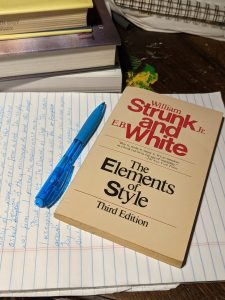
“If you have any young friends who aspire to become writers,” Dorothy Parker once wrote, “the second-greatest favor you can do them is to present them with copies of The Elements of Style.The first-greatest, of course, is to shoot them now, while they’re happy.”
I have a friend who loves jigsaw puzzles. Last year she posted a pic of a puzzle she’d finished solving that consisted solely of a single page of text. She coyly asked if anyone recognized the book the page was from. Immediately I replied: Strunk and White’s “Elements of Style”.
The reason I recognized a page of random text so readily was because it was the English writing style guide required to write essays at my old alma mater, U of Guelph way back when. Therefore, I had spent six years writing papers using that book as a writing benchmark.
Now, the edition we used back then was already the Third Edition, published 1979. I found a reference to it twenty years after my co-ed days describing Elements as a “really solid mainstay for all those who fancy themselves a writer.”
Quite the accolade for any book, even if the latter part seems rather dismissive of writers themselves.
Anyway, as someone who fancies herself as a writer,and belonging to a writers’ group that encourages us to share books on writing, I figured it wouldn’t hurt to take another look through the pages – if for no other reason than auld lang syne.
Would there still be something of relevance for a present day writer in a book touted to be among the 100 best and most influential written in English since 1923?
So the five elements of style consist of the following:
ELEMENTARY RULES OF USAGE; ELEMENTARY PRINCIPLES OF COMPOSITION; A FEW MATTERS OF FORM;WORDS AND EXPRESSIONS COMMONLY MISUSED; AN APPROACH TO STYLE (WITH A LIST OF REMINDERS).
(I’ll leave it to you to decide if you need to peruse these yourself).
The fifth element, An Approach to Style, is readily digestible. I agreed with most of the rules. Easily found three succinct “reminders” among the list that I believe still holds true for writers of the 21st century:
Write in a way that comes naturally, revise and rewrite, be clear.
Perfect.
But then, there were these:
“Do not affect a breezy manner; avoid fancy words; prefer the standard to the offbeat.”
Hmmmm, ‘kay. Maybe this could use a bit of leeway.
The Elements of Style is still hailed as one of the best books about writing. I’ll be one of the first to recommend you look it over. As an English tutor, I understand that most people need to master the rules before they can break them. But as a reader, I love to hear that original voice, the offbeat to the standard—in word choice, in subject matter, in structure. Those writers who haven’t had the stuffing knocked out of them, and who still have a chance to be wildly themselves.
There is no writing guide that can actually teach you style that will translate into your authentic voice. It’s in choosing which rules to learn, and which to break, and when, and to what end, that you can begin to construct your own.